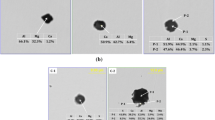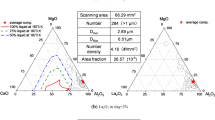Abstract
Attempts were made to elucidate the formation mechanism of CaO-SiO2-based inclusions in saw wires by both laboratory experiments and industrial trials. The key point was to make clear the origin of CaO in such oxide inclusions. Probable origins of [Ca] in steel were first discussed, which can be taken into steel from the steel-slag reaction or ferrous alloy. As a result, slag-steel chemical reaction equilibrium was carefully evaluated at 1873 K (1600 °C) to classify the changes of dissolved aluminum ([Al]), total magnesium (Mg), and total calcium (Ca) in steel and the caused composition variations of inclusions. With the rise of slag basicity from 0.5 to 1.8, [Al] was remarkably increased from 0.00045 to 0.00139 mass pct, whereas Mg varied in the range of 0.00038 to 0.00048 mass pct. By contrast, Ca was constantly kept below 0.00003 mass pct. Accordingly, Al2O3 and MgO in inclusions witnessed obvious rises from 5 to 23 mass pct and from 2 to 8 mass pct, respectively. By contrast, inclusions were free of CaO when slag basicity was below 1.5. With slag basicity further increased to 1.8, CaO witnessed a negligible rise to only 1.0 mass pct on average. This phenomenon agreed well with thermodynamic calculations, which revealed that chemical reaction between steel and CaO in slag (for example, between [Si] and CaO) was weak to hardly supplying sufficient [Ca] to steel to increase CaO in inclusions. Ca contained in ferrous alloys as contaminations was not the cause of CaO-SiO2-based inclusions, either. The industrial trial results indicated that CaO-SiO2-based inclusions have been readily produced in short time just after BOF tapping. Also, a percentage of them changed slightly with the proceeding of refining. Based on the good agreement of laboratory, industrial, and thermodynamics calculations results, it can be reasonably concluded that CaO-SiO2-based inclusions in saw wire were exogenous particles from entrapped/emulsified top slag, but not products of slag-steel-inclusion chemical reactions.







Similar content being viewed by others
Notes
JEOL is a trademark of Japan Electron Optics. Ltd., Tokyo.
References
L. Peeters: Wire J. Int., 1980, vol. 13, pp. 96–99.
E.G. Demeye: Wire J. Int., 1981, vol. 14, pp. 72–77.
M. Barous and G. Mangel: Wire J. Int., 1984, vol. 17, pp. 66–71.
K. Iemura, H. Ichihashi, A. Kawami, and M. Mizutani: Proc. 3th Int. Conf. on Clean Steel, Brookfield, 1986, pp. 160–67.
A. Ueno, K. Kimura, A. Kawami, and M. Mizutani: 70th Steelmaking Conf. Proc., Pittsburgh, PA, 1987, pp. 389–95.
Y. Shinsho, T. Nozaki, K. Sorimachi, E. Yamanaka, K. Suzuki, and K. Nakanishi: Wire J. Int., 1988, vol. 21, pp. 145–53.
S. Maede, T. Soejima, T. Saito, H. Matsumoto, H. Fujimoto, and T. Mimura: 72nd Steelmaking Conf. Proc., Chicago, IL, 1989, pp. 379–85.
H. Ohta and H. Suito: Metall. Mater. Trans. B, 1996, vol. 27B, pp. 263–70.
G.M. Fauling: Ironmaker & Steelmaker, 1999, vol. 26, pp. 29–36.
Y.B. Kang and H.G. Lee: ISIJ Int., 2004, vol. 44, pp. 1006–15.
K. Karihara: Kobelco Technol. Rev., 2011, vol. 30, pp. 62–65.
J.D. Seo, Y.T. Kim, and D.H. Kim: 5th Int. Congr. on the Science and Technology of Steelmaking, Dresden, Germany, 2012, pp. 1250–54.
K.P. Wang, M. Jiang, X.H. Wang, Y. Wang, H.Q. Zhao, and Z.M. Cao: Metall. Mater. Trans. B, 2015, vol. 46B, pp. 2198–2207.
K.P. Wang, M Jiang, X.H. Wang, Y Wang, H.Q. Zhao, and Z.M. Cao: Metall. Mater. Trans. B, 2016, vol. 47B, pp. 282–90.
S.H. Chen, M Jiang, X.F. He, and X.H. Wang: Int. J. Miner. Metall. Mater., 2012, vol. 19, pp. 490–98.
X.F. He, X.H. Wang, S.H. Chen, M. Jiang, F.X. Huang, and W.J. Wang: Ironmaking & Steelmaking, 2014, vol. 41 (9), pp. 676–84.
H.T. Ling, C.B. Guo, L.F. Zhang, C. Liu, G.S. Wang, and Y.B. Gao: Steelmaking, 2016, vol. 32 (4), pp. 33–38 (in Chinese).
C.P. Xin, F. Yue, L.L. Tian, and Q.F. Wu: Steelmaking, 2015, vol. 31 (1), pp. 48–51 (in Chinese).
K. Mizuno, H. Todoroki, M. Noda, and T. Tohge: Trans. ISS, 2001, vol. 22, pp. 93–101.
M. Jiang, X.H. Wang, B. Chen, and W.J. Wang: ISIJ Int., 2010, vol. 50, pp. 95–104.
J.Z. Li, M Jiang, X.F. He, W. Sun, and X.H. Wang: Metall. Mater. Trans. B, 2016, vol. 47B, pp. 2386–99.
Z.Y. Deng and M.Y. Zhu: ISIJ Int., 2013, vol. 53, pp. 450–58.
J.S. Park and J.H. Park: Metall. Mater. Trans. B, 2014, vol. 45B, pp. 953–60.
Y. Ren, L.F. Zhang, W. Fang, S.J. Shao, J. Shao, and W.D. Mao: Metall. Mater. Trans. B, 2016, vol. 47B, pp. 1024–34.
R. Kiessling and N. Lange: Non-Metallic Inclusions in Steel, Part III, Iron and Steel Institute, London, 1978.
“Recommended Values of Equilibrium Constants for the Reactions in Steelmaking,” Japan Society for the Promotion of Science, 19th Committee, 1984.
S. Gustafsson and P. Mellerg: Scand. J. Metall., 1980, vol. 9, pp. 111–16.
S. Cho and H. Suito: ISIJ Int., 1994, vol. 34, pp. 177–85.
S. Dimitrov, A. Weyl, and D. Janke: Steel Res., 1995, vol. 66, pp. 3–7.
H. Itoh, M. Hino, and S. Ban-ya: Tetsu-to-Hagané, 1997, vol. 83, pp. 773–78.
J. Seo, S. Kim, and K. Lee: Steel Res., 1998, vol. 69, pp. 49–53.
H. Fujisawa, A. Hattori, and E. Ichise: Tetsu-to-Hagané, 1999, vol. 85, pp. 201–07.
H. Ohta and H. Suito: Metall. Mater. Trans. B, 1994, vol. 25B, pp. 235–44.
H. Ohta and H. Suito: Metall. Mater. Trans. B, 1997, vol. 28B, pp. 1131–39.
H. Itoh, M. Hino, and S. Ban-ya: Tetsu-to-Hagané, 1997, vol. 83, pp. 623–28.
J.D. Seo and S.H. Kim: Steel Res., 2000, vol. 71, pp. 101–06
T. Wakasugi, H. Tsukihashi, and N. Sano: Tetsu-to-Hagané, 1989, vol. 75, pp. 2018–22.
S. Cho and H. Suito: ISIJ Int., 1994, vol. 34, pp. 265–69.
Acknowledgments
The authors express their sincere gratitude and appreciation to the National Natural Science Fund (Grant No. 51304013), for supporting the laboratory experiments, and to Xingtai Iron & Steel Co., Ltd., for supporting the industrial trials and samplings. The authors also thank Professor Joo-Hyun Park, Hanyang University, for his valuable advice and meaningful discussions.
Author information
Authors and Affiliations
Corresponding author
Additional information
Manuscript submitted July 26, 2016.
Rights and permissions
About this article
Cite this article
Wang, KP., Jiang, M., Wang, XH. et al. Study on Formation Mechanism of CaO-SiO2-Based Inclusions in Saw Wire Steel. Metall Mater Trans B 48, 2961–2969 (2017). https://doi.org/10.1007/s11663-017-1055-0
Received:
Published:
Issue Date:
DOI: https://doi.org/10.1007/s11663-017-1055-0




